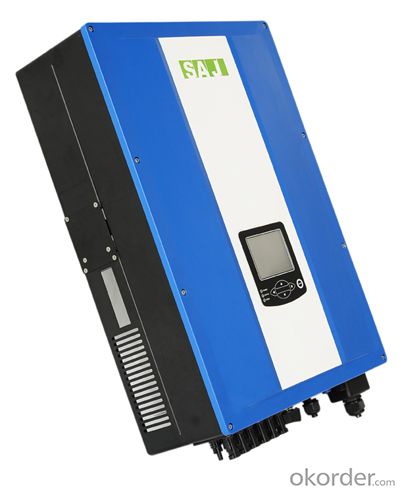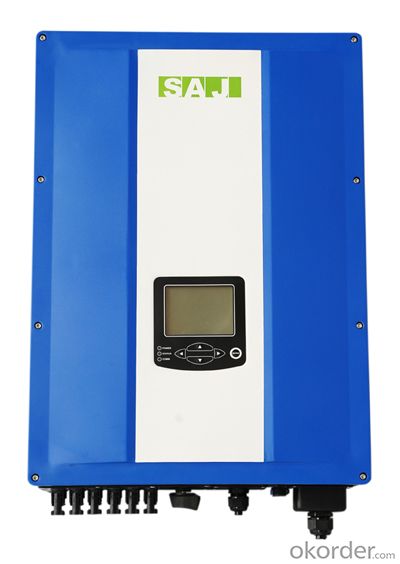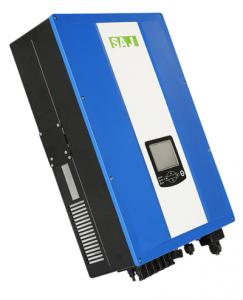On gird solar inverter Suntrio-TL5K with 2MPPT
- Loading Port:
- Guangzhou
- Payment Terms:
- TT OR LC
- Min Order Qty:
- 1 watt
- Supply Capability:
- 3000 watt/month
OKorder Service Pledge
OKorder Financial Service
You Might Also Like
Suntrio-TL5K/6K/8K/10K PV inverters are transformerless inverters with efficiency of up to 97.5%. Multi-MPPT inputs provides higher flexibility for the project installation. Stainless steel housing and IP65 protection guarantee use both indoor and outdoor for long. The series inverters are ideally suited for medium and commercial PV projects of up to MW range.
1. Leading technology
· Max. efficiency 98.0%
• MPPT accuracy up to 99.9% efficiency
• Compliant with VDE-AR-N 4105
2. User-friendly
• 5 inch LCD display with comprehensive information
• Embedded webserver monitoring
• Easy installation
3. Flexible
• Multi-country configuration
• RS485 / Ethernet / Wi-Fi communication
• Wide range of DC input voltage
• IP65 for indoor and outdoor
4. Certificates: TUV,SAA,G83,ISO9001,ISO14001,etc.


FAQ
1. How long will my inquiry get response?
Your inquiry related to our products or prices will be replied within 24 hours.
2. Can I get professional service and suggestion?
Well-trained and experienced staffs to answer all your questions in fluent English.
3. Do you accept OEM or customized design?
OEM & ODM, any your customized lightings we can help you to design and put into product.
4. What if I need specific design?
Distributorship are offered for your unique design and some our current models.
- Q:What is the role of a bypass switch in a solar inverter?
- The role of a bypass switch in a solar inverter is to provide a means for redirecting the flow of electricity in case of an emergency or failure within the inverter. It allows for the direct connection of the solar panels to the utility grid, bypassing the inverter, ensuring a continuous supply of electricity even when the inverter is not functioning properly. This helps maintain the stability and reliability of the solar power system.
- Q:Can a solar inverter be used with a solar-powered air conditioner?
- Yes, a solar inverter can be used with a solar-powered air conditioner. The solar inverter is responsible for converting the direct current (DC) produced by the solar panels into alternating current (AC) that can be used to power electrical appliances, including air conditioners. By connecting the solar inverter to the solar panels and then to the solar-powered air conditioner, the AC produced by the inverter can be utilized to run the air conditioner, effectively making it solar-powered.
- Q:Can a solar inverter be used in systems with different module capacities?
- Yes, a solar inverter can be used in systems with different module capacities. Solar inverters are designed to convert the DC power generated by solar panels into AC power for use in the electrical grid or for consumption. They are typically compatible with a wide range of module capacities and can accommodate various configurations of solar panels. However, it is important to ensure that the solar inverter's specifications and capacity match the overall system requirements to ensure optimal performance and efficiency.
- Q:Can a solar inverter be used in regions with extreme weather conditions?
- Yes, a solar inverter can be used in regions with extreme weather conditions. However, it is important to choose an inverter that is designed and rated for the specific weather conditions of that region. For example, there are solar inverters available that are built to withstand high temperatures, extreme cold, humidity, and even harsh weather events such as hurricanes. It is crucial to consider the environmental factors and select an inverter that is suitable for the specific climate conditions to ensure optimal performance and longevity.
- Q:In a photovoltaic grid-connected project, the role of the inverter is to convert the voltage into AC 220V or 380V for the grid, since the transformer will raise the voltage again
- Unless the power is not issued for their own use, is to be sent to other areas, it needs to boost, such as the western region of those large power stations
- Q:What is the difference between a string inverter and a micro inverter?
- A string inverter is a type of inverter that is connected to a string of solar panels, converting the DC power generated by the panels into AC power for use in the electrical grid. On the other hand, a micro inverter is a smaller and individual inverter that is attached to each solar panel, converting the DC power directly at the panel level. The main difference between the two is that a string inverter operates at the string level, which means if one panel in the string is affected by shade or malfunction, the entire string's performance is affected. In contrast, with micro inverters, each panel operates independently, allowing for higher energy production and better performance in situations where panels are subjected to shading or varying conditions.
- Q:How does a solar inverter handle voltage regulation?
- A solar inverter handles voltage regulation by continuously monitoring the incoming voltage from the solar panels and adjusting its output voltage accordingly. It ensures that the voltage produced by the solar panels is converted to the appropriate level for efficient use in the electrical system. This helps to maintain a stable and consistent voltage output, protecting the connected devices and optimizing energy conversion.
- Q:Can a solar inverter be used in a net metering system?
- Yes, a solar inverter can be used in a net metering system. A solar inverter is an essential component of a net metering system as it converts the direct current (DC) produced by the solar panels into alternating current (AC) that can be used to power homes or businesses. It also allows for any excess electricity generated to be fed back into the grid, earning credits or reducing the electricity bill through the net metering arrangement.
- Q:Installation and maintenance of photovoltaic grid - connected inverter
- only when the local power sector permission by the professional and technical personnel to complete all the electrical connection before the inverter can be connected.
- Q:How do you choose the right input voltage range for a solar inverter?
- To choose the right input voltage range for a solar inverter, you need to consider the specifications of your solar panels and the requirements of the inverter. You should check the voltage output range of your solar panels and ensure that the inverter's input voltage range is compatible with it. Additionally, consider any potential variations in solar panel output due to factors like temperature and shading. It is advisable to choose an inverter with a slightly higher input voltage range to accommodate any fluctuations and maximize the efficiency of the system.
1. Manufacturer Overview |
|
|---|---|
| Location | |
| Year Established | |
| Annual Output Value | |
| Main Markets | |
| Company Certifications | |
2. Manufacturer Certificates |
|
|---|---|
| a) Certification Name | |
| Range | |
| Reference | |
| Validity Period | |
3. Manufacturer Capability |
|
|---|---|
| a)Trade Capacity | |
| Nearest Port | |
| Export Percentage | |
| No.of Employees in Trade Department | |
| Language Spoken: | |
| b)Factory Information | |
| Factory Size: | |
| No. of Production Lines | |
| Contract Manufacturing | |
| Product Price Range | |
Send your message to us
On gird solar inverter Suntrio-TL5K with 2MPPT
- Loading Port:
- Guangzhou
- Payment Terms:
- TT OR LC
- Min Order Qty:
- 1 watt
- Supply Capability:
- 3000 watt/month
OKorder Service Pledge
OKorder Financial Service
Similar products
New products
Hot products
Hot Searches
Related keywords






























